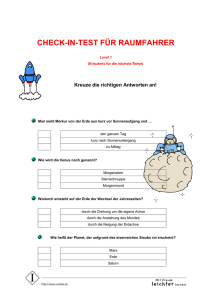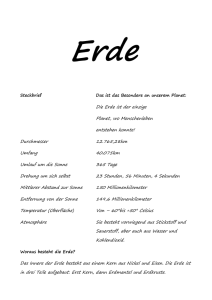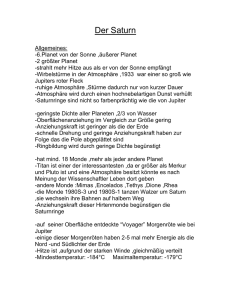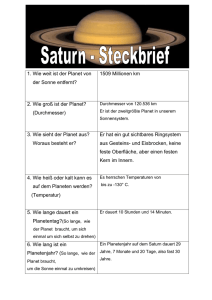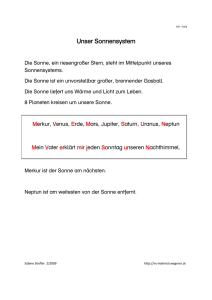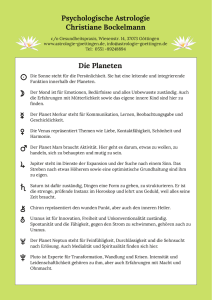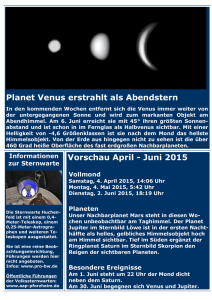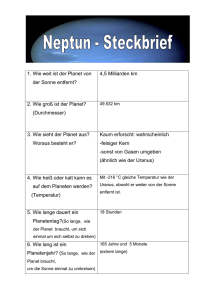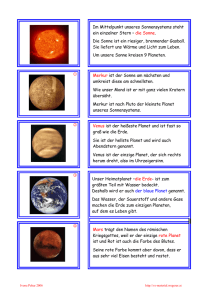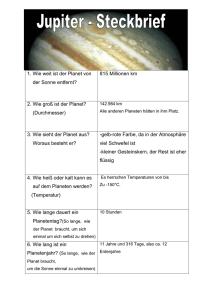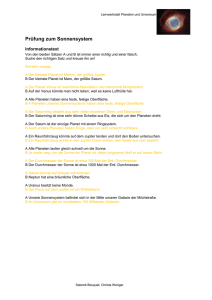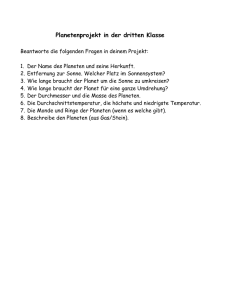Habitable Zone
Werbung
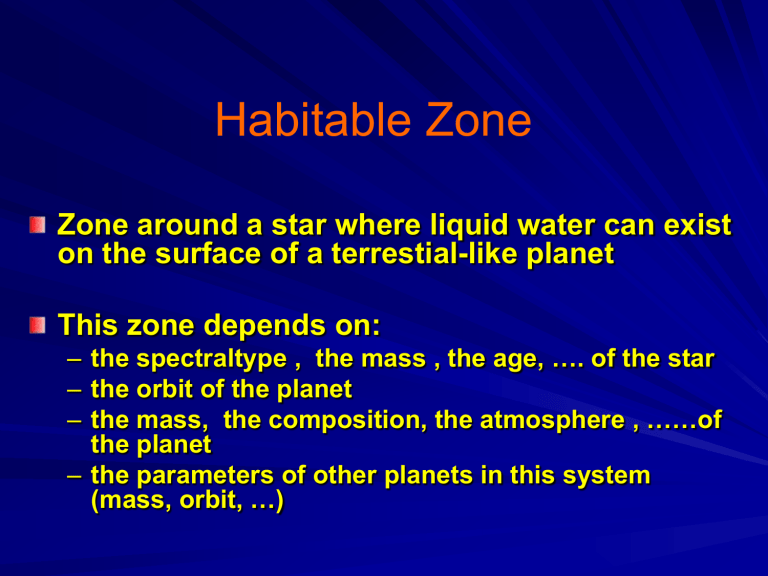
Habitable Zone Zone around a star where liquid water can exist on the surface of a terrestial-like planet This zone depends on: – the spectraltype , the mass , the age, …. of the star – the orbit of the planet – the mass, the composition, the atmosphere , ……of the planet – the parameters of other planets in this system (mass, orbit, …) Huang (1959, 1960) führte den Begriff „habitable zone“ Dole (1964), Shklovski & Sagan (1966) sprachen von „ecosphere“ Region um einen Stern, wo sich auf einem Planeten Leben entwickeln kann. Sonnenentwicklung Leuchtkraft der Sonne (Lo) nimmt zu: hatte zu Beginn 0.71 von Lo wird ca. 3xLo haben am Ende der Hauptreihenphase ca. 300Lo in der Roten Riesen Phase und wächst auf 6000 Lo an in der AGB Phase Änderung der Sonnenenergie -> Änderung der effektiven Temp. Habitable Zone & Star Evolution CHZ = continuously habitable zone = Bereich der über mehrere Jahrmilliarden in der HZ liegt (Sternentwicklu ng!) HZ im Sonnensystem (Kasting) innere Grenze: 0.95 AU (Wasserdampf bildet sich in der Stratosphäre), bzw. 0.85 AU (Temperaturanstieg infolge eines runaway greenhouse-Effekts) äußere Grenze bei 1.37 AU (Bildung von CO2Wolken) CHZ zwischen 0.95 und 1.15 AU Size of the habitable zone based on the definition given by Kasting et al. (1993). Planet ist außerhalb der HZ Planet benötigt eine interne Wärmequelle um Eis od. Permafrost zu schmelzen Planet ist näher beim Stern als HZ Wasser würde verdampfen WASSER – H20 Wasserstoff entstand im Gefolge des Urknalls. Unter Bedingungen, die an vielen Stellen von Galaxien herrschen (niedere Temperaturen, Existenz von interstellaren Staubteilchen - an deren Oberflächen H mit H reagiert) kam/kommt es zur Bildung von H2. Sauerstoff wurde/wird bei ≥500 Mio. Grad im Inneren von Sternen erzeugt. Durch Konvektion wird ein Teil des O an Sternoberfläche transportiert und in weiterer Folge gelangt Materie auch in den interstellaren Raum (etwa bei Supernova-Explosionen). Aus ISM entstehen neue Sterne + Planeten + Monde +… WICHTIGE FRAGEN ZUM THEMA BEWOHNBARKEIT VON PLANETEN: WAS HAT UNSER PLANETENSYSTEM WAS ANDERE NICHT HABEN? WAS HAT UNSERE ERDE WAS ANDERE PLANETEN NICHT HABEN? GRUNDVORAUSSETZUNGEN FÜR UNSER LEBEN WAS HAT UNSER PLANETENSYSTEM? RICHTIGE ZENTRALGESTIRN: • Unsere Sonne ist der optimale Stern für komplexes Leben • Ausreichend lange Lebenszeit des Sterns • Zeigt nicht zu viel Aktivität • Nicht zu hohe UV Strahlungsanteile STABILE UMLAUFBAHNEN DER PLANETEN: • Großplaneten dürfen kein orbitales Chaos verursachen GASPLANETEN VON DER GRÖSSE JUPITERS: • Nicht zu weit entfernt, aber auch nicht zu nahe • Großplanet schützt vor Kometen und Asteroiden EIN MARSÄHNLICHER PLANET: • Ein kleiner Nachbar, als mögliche Quelle des Lebens. (Hat ein Marsmeteorit das Leben auf die Erde gebracht?) WAS HAT UNSERE ERDE WAS ANDERE PLANETEN NICHT HABEN? RICHTIGE ENTFERNUNG VON DER SONNE: • Erde ist weit genung von der Sonne entfernt, um umlaufsynchrone Planetenrotation zu verhindern (Merkur: gebundene Rotation) • Flüssiges Wasser an der Oberfläche • Geeignete Umweltbedingungen für komplexes Leben EIN GROSSER MOND: • In der richtigen Entfernung • Stabilisiert die Neigung der Erdachse RICHTIGE NEIGUNG DER PLANETENACHSE: • Nicht zu starke jahreszeitliche Schwankungen GIGANTISCHE EINSCHLÄGE AUS DEM ALL: Nicht zu viele Kein sehr großer Einschlag, der zur globalen Sterilisation in der Anfangszeit führt. RICHTIGE PLANETENMASSE: • Atmosphäre und Ozean werden gehalten • Genügend Eigenwärme damit Plattentektonik statt findet • Fester bzw. Geschmolzener Kern OZEANE: • nicht zu viele und nicht zu wenige PLATTENTEKTONIK: • Karbonat-Silikat-Zyklus als langfristiger Thermostat • Bildung von Landmassen • Aufbau eines Magnetfeldes RICHTIGE ATMOSPHÄRE: • Richtiger Gehalt an Kohlenstoff (genügend für die Organismen aber nicht zu viel, damit es nicht zum Treibhauseffekt a la Venus kommen kann) • für passende Temperatur, • chemische Zusammensetzung, • adäquater Luftdruck für Pflanzen und Lebewesen SAUERSTOFFANREICHERUNG IN ATMOSPHÄRE • Entwicklung der Photosynthese • Nicht zu viel und nicht zu wenig • Beginn zum richtigen Zeitpunkt Habitable Zone Zone around a star where liquid water can exist on the surface of a terrestial-like planet This zone depends on: – the spectraltype , the mass , the age, …. of the star – the orbit of the planet – the mass, the composition, the atmosphere , ……of the planet – the parameters of other planets in this system (mass, orbit, …) Habitable Zone aus dynamischer Sicht Langzeitstabilität der Planetenbahnen kleine Exzentrizitäten 60% haben e > 0.2 40% haben e > 0.3 Types of Habitable Zones: (1)Hot-Jupiter type (2) Solar system type (3)+(4) giant planet type: habitable moon or trojan planet Extra-solare Planetensysteme: 1Stern – 1Gasplanet 1Stern – mehrere Gasplaneten ExoStab nicht anwendbar DoppelStern – 1Gaspl. What‘s ExoStab? A www-tool that helps to verify the stability of a terrestrial planet in Single Star and Single Planet Systems www.univie.ac.at/adg/exostab/ E.Pilat-Lohinger, S. Eggl, Th. Winkler www.univie.ac.at/adg/exostab/ ExoStab appropriate for single-star single-planet system - Stability of an additional planet - Stability of the habitable zone (HZ) - Stability of an additional planet with repect to the HZ Stability of an additional planet known parameters of system: mass of star [M_sun]: 0.51 mass of giant planet [M_jup]: 0.271 semi-major axis of giant planet [AU]: 4.5 eccentricity of giant planet: 0.15 +/- error of eccentricity: 0.1 newly discovered planet: Probable range of semi-major axis for the new planet: semi-major axis of planet [AU]: 2.3 +/- error of semi-major axis: 0.5 System Data Exocatalogue Data mass of star: 0.5 [M_sun] mass of giant planet: 0.0003 [M_sun] semi-major axis of giant planet: 4.5 [AU] eccentricity of giant planet: 0.15 + error of ecc of giant planet: 0.25 - error of ecc of giant planet: 0.05 inner border of add. Planet: outer border of add. Planet: mass ratio: 1.8 [AU] 2.8 [AU] 0.0005 additional information: 1 0.4 0.62 0.0005 The EXOCATALOGUE: http://www.univie.ac.at/adg/ 552 Stabilitymaps --- mass-ratios 0.0001 – 0.05 Details: Sándor, Zs., Süli, A., Érdi, B., Pilat-Lohinger, E. and Dvorak, R.: "A Stability Catalogue of the Habitable zones in Extrasolar Planetary Systems", Monthly Notices of the Royal Astronomical Society (MNRAS), 2006 How to use the catalogue HD114729: m_p=0.82 [Mjup] (0.93 [Msun]) a_p= 2.08 AU e_p=0.31 mr=0.001 HZ: 0.7 – 1.3 AU µ = 0.005 HD10697: (1.15 Msun) m_p= 6.12 [Mjup] a_p = 2.13 AU e_p = 0.11 HZ: 0.85 – 1.65 AU Target star catalogue for Darwin (L. Kaltenegger ) ExoStab applied to Darwin target stars: 70Vir, HD285968, GJ674, -- Gl86,HD242, HD10647 -- HD17051, HD27442, HD33564 HD52265, HD70642, HD93083 -- HD101930, HD111232, HD114386 HD114783,HD134987, HD150706 -- HD154345, HD164922,HD216437 Multi-planetary systems: Classification of the known multi-planet systems (S.Ferraz-Mello, 2005) Class Ia –> Planets in mean motion resonance Class Ib Low-eccentricity near-resonant planet pairs Class II Non-resonant planets with significant secular dynamics Class III Hierarchical planet pairs Giant planets near the 5:2 resonance and their influence on terrestrial planets in the habitable zone E. Pilat-Lohinger (Univ.Vienna) Aron Süli (Univ.Budapest) Philippe Robutel (IMCCE) Florian Freistetter (Univ. Jena) Motivation A study of Extra-solar planetary systems similar to our solar system Initial Conditions and Computations Saturn: a_sat = 8 ..... 11 AU m_sat = 1 .... 30xm_Sat Testplanets in the HZ: a_tp = 0.6 ..... 1.6 AU circular motion Mercury 6 (J. Chambers) Integration time: 20 mio years HZ: maximum ecc. HZ im Sonnensystem: Kasting: 0.93 – 1.3 AU Mischna: 0.93 – 1.7 AU Forget: 0.93 – 2 AU a< 0.93 AU H2O becomes a major atmospheric compound and is rapidly lost to space after UV photolysis a>1.3 AU CO2 condensates in the atmosphere producing CO2-clouds, that can affect significantly the T-CO2 coupling Sun – Jupiter – Saturn (See e.g. Murray & Dermott, Solar System Dynamics) Sun – Jupiter – Saturn Influence of a third giant planet Jupiter – Saturn -Uranus Jupiter -- Saturn Influence of a third giant planet Jupiter – Saturn -Uranus Jupiter -- Saturn Sun-Jupiter-Saturn-Uranus Influence on an Earth-like planet at 1 AU Initial Conditions and Computations Jupiter: on its orbit Mercury 6 (J. Chambers) Saturn: a_sat = 8 ..... 11 AU Integration time: 20 mio years i_sat = 10 .... 60 deg Testplanets in the HZ: a_tp = 0.6 ..... 1.6 AU HZ: maximum ecc. Sun – Jupiter – Saturn Increase of iSaturn = 10 deg Orbits of Venus, Earth and Mars iSaturn = 20deg Escape of Saturn for a_Sat = 8.2 AU iSaturn = 30deg iSaturn = 40 deg iSaturn = 50 deg iSaturn = 60 deg Saturn will escape except for aSaturn = 9.6 AU Summary The inclination of Saturn influences the inner Solar system For small i -- the two planets in MMR High i -- may lead to escapes of Saturn For i > 60 all systems are unstable Sun – Jupiter – Saturn Increase of eEarth , if Saturn is at 8.7 AU Changes due to Uranus .... and Neptune ... Sun – Jupiter – Saturn Earth orbit changes from nearly circular to highly eccentric Secular Periode: ~ 21 mio yrs Decrease in eccentricity due to Venus !
